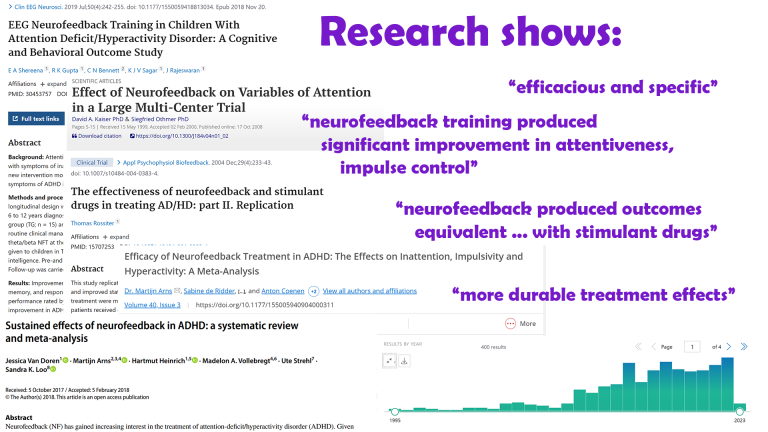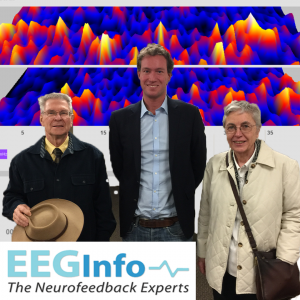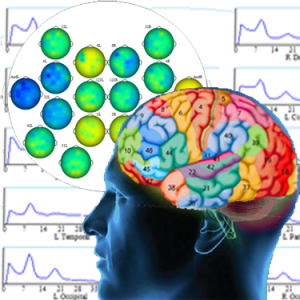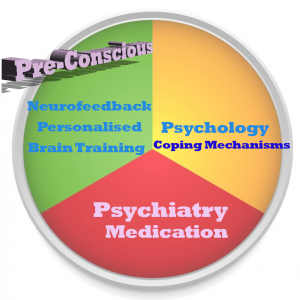The History of Neurofeedback
Quick Navigation
Research Milestones
Overview
The seminal discovery that neurofeedback can resolve cases of intractable epilepsy was made in 1972, over fifty years ago. Since then, it has been shown to be an effective treatment for many other health conditions, and proven to make positive structural changes to the brain. Its use potential has expanded, as have the number of methods; the key steps and methodologies are described here.
The genesis of neurofeedback can be traced to a confluence of discoveries:
– Brodmann’s mapping of discrete brain areas by function in 1909
– Berger’s discovery of the alpha rhythm as the resting rate of the cortex in 1924
– advances and interest in biofeedback as a way of training behaviours by giving the brain feedback about physiological states
– application of this principle to EEG, or brain behaviour
– mathematical analysis of qEEG brain recordings, and development of mapping methods
– the Othmer Method of neurofeedback, or Infra-Low (ILF)
– David Kaiser’s Default Network Training, based on a Kaiser Neuromap
Functional Brain Areas - Brodmann
Until the last century, our brain was the only organ that we have not been able to look into with regard to its function.
In 1909, Korbinian Brodmann published his work “Localisation in the Cerebral Cortex”, where he identifies 47 functional brain areas of the cortex by their differing cytoarchitecture. This parcellation still largely holds until today. It forms the basis of an ever-growing wealth of research investigating which brain areas are activated by different conditions, responses to our environment, psychological phenomena and pathologies. His numbering provides an easy reference to specific parts of the brain that is widely used. The idea that discrete brain areas have specific functions, in isolation and as part of various networks of activation, was thus cemented.
The cerebral cortex is a highly evolved 3D structure that consists, in essence, of two folded sheets (one for each hemisphere) roughly 3mm thick, that would span an area of 2,000cm2, or the size of a large pizza. These ‘sheets’ of gray matter have up to six layers of different types of cells (neurons), with varying consistency. The make-up of these layers, that is, their changing thickness and connections, is called cytoarchitecture; where a change occurred from one part to another, Brodmann assigned a delineation, thus dividing the cortex into around 50 distinct, numbered areas.
The idea that different parts of the brain give rise to psychological attributes had been spawned in the early 1800s. Constrained by an inability to look inside the skull, or even measuring localised activity, Phrenology had been discredited before Brodmann’s seminal work. His approach reinvigorated the concept that psychological phenomena have a neural basis, and forms the foundation of thousands of research articles relating behaviours to the activity of specific brain areas, in isolation and in networks. With the advent of fMRI technology in the early 2000s, this could be studied real-time and with novel precision, resulting in almost 200 research reports per year for the last decade.
Further, brain behaviour in various pathologies or mental health conditions can now be related to the interaction and activity of functional brain areas. The approach to mental health of thinking about behavioural patterns and psychological phenomena in terms of neural correlates has many benefits. It is more general and informative than analysing patterns at the molecular level or chemical balances, and more specific than subjective categorisation based on observed behaviour. We can gain insight into preconscious dispositions and vulnerabilities, which may be masked by conscious behaviour.
Discovery of EEG - Hans Berger
Twenty-five years after Brodmann’s publication, Hans Berger performed the first EEG recording in 1924. The small, microvolt current measurable on the surface of the skalp had hitherto been dismissed as ‘noise’. Berger saw distinct alpha ‘spindles’ – second long bursts of 10Hz activity – prominently appear when his subject was relaxed at rest, not sleeping, especially in the parietal and occipital regions. Not only was this evidence of organised electrical activity, it also related to a beneficial state (relaxed daydreaming). This raised the prospect of further discoveries once the recorded EEG signal could be broken down into its constituents by wavelength using advanced mathematical methods. It also prompted efforts to train the signal in order to prompt changes in state.
Pioneering Biofeedback - East meets West
Another emerging practice in the mid-20th century was biofeedback. Biofeedback is a technique whereby a person can learn to control functions of the body which are normally regulated subconsciously, such as blood pressure and flow, head muscle tension, perception of pain, breath and heart rate. Voluntary control is gained by giving the brain feedback, through visual or auditory stimulus, on whether the desired state is being attained or not. It is essentially ‘operant conditioning’, or a reward / inhibit protocol (‘carrot and stick’).
A pioneer of biofeedback was Elmer Green. In the 1950s, strongly influenced by his study of Buddhism, he took to experiments to demonstrate the power of the mind over body. The following video – “Biofeedback: The Yoga of the West” – illustrates Professor Green’s endeavours. In 1974 Elmer Green traversed India with a portable psychophysiologic laboratory to study the self-regulation achieved by yogis:
Dr. Elmer Green travels to India in the 1970s to conduct mind-body studies with yoga masters. This is then applied to children in the US, as well as prison inmates. An introduction to biofeedback, blending yoga with Western technology. A 40min. film.
From Heart Rate to Brain Waves
In the 1950s, Dr. Joe Kamiya at the University of Chicago began applying the concept of biofeedback to training the brain’s activity itself, using EEG rather than heart rate measurements or the like. His experiments were largely about inducing ‘alpha’ state and conditioning his subjects to being able to tell which brain state is dominant. Dr. Kamiya describes the work that first brought neurofeedback into the public eye and earned him the title ‘father of neurofeedback’ in this video:
Seizure Resistance through Neurofeedback
In 1972, Barry Sterman found that neurofeedback training could improve seizure resistance and demonstrated efficacy of neurofeedback for treatment-resistant epilepsy: Barry Sterman was able to cure a 23-year old female epileptic from seizures using his SMR-biofeedback training over the course of two-and-a-half years. The alternative medicinal use of neurofeedback was thus established.
Simultaneously, Barry Sterman was experimenting with cats along similar lines. They would get a reward if they could produce, or increase, the dominance of low beta (13-15Hz) waves, also called SMR or the sensorimotor rhythm, as measured across the sensorimotor cortex. Also known as the ‘motor strip’, this part of they brain is effectively a ‘strip’ from ear to ear on the outer layer of the brain, and unsurprisingly, controls movement by sending signals down through the spinal cord. (These are refined by the cerebellum at the back of the brain, but the cerebellum doesn’t have an EEG). For the difference between brain waves, see this table. While alpha and theta waves relate to less conscious deeper states, beta is very much in the cognitive realm, and Barry Sterman took his research to study seizure in epilepsy, and also ADHD. His cats, having learned to feed themselves by producing more beta waves, ended up in an experiment in the 1960s space programme. Here, fearing that rocket fuel fumes could adversely affect astronauts, cats were injected with said substance and it transpired that the cats who had been tended to by Dr. Sterman before were seizure resistant, unlike cats that had not received his neurofeedback. Barry Sterman was able to cure a 23-year old female epileptic from seizures using his SMR-biofeedback training over the course of two-and-a-half years. The alternative medicinal use of neurofeedback was thus established.
Expanded Applications
In the 1970s, Dr. Joel Lubar advanced the use of neurofeedback to start treating ADD / ADHD. He also began creating a database for the assessment of individuals with this focus instability, which expanded into the LoRETA database still used.
With essential and exciting groundwork laid by Green, Kamiya, Sterman (and his cats), and Joel Lubar, Neurofeedback entered the mainstream narrative when it came to severe mental health issues. Unfortunately for this non-invasive, drug-free alternative medicine, the 70s saw an emergence of targeted psychiatric drugs, whose use could be scaled and monetised more readily. It was not until the mid 1980s that neurofeedback experienced a kind of renaissance when the Othmer s entered the field.

Pioneers
Joe Kamiya, Barbara Brown, Elmer Green, Lester Fehmi, Jim Hardt, Tom Budzynski, Barry Sterman, Joel Lubar, and Niels Birbaumer in the first generation; Patricia Norris, Eugene Peniston, Margaret Ayers, Ute Strehl, Jayu Gunkelman, Corydon Hammond, Les Fehmi, Sebern Fisher, Jim Evans, Juri Kropotov, Joel Lubar, Len Ochs, Robert Thatcher, Ruth Lanius, Sue and Siegfried Othmer and David Kaiser in the second.
Neurofeedback Applications by year of First Publication
1967 SMR conditioning in general
1973 Epilepsy
1975 Peak Performance
1976 ADHD
1977 Addiction
1978 Anxiety Disorders
1978 Learning Disabilities
1980 Sleep Disorders
1995 Brain Injury
1995 Lyme Disease
1996 CFS
1997 Mood Disorders
The Othmer Method

Having trained in the regular band, predominantly alpha and SMR, throughout the 90s, the Othmer Method was extended to the infra-low frequency region. Instead of training frequencies of 7-20Hz, this meant training much slower waves under 1Hz, or one oscillation per second, and in fact wavelengths ranging from 30 seconds and much more. This was enabled by Bernard Wandernoth’s NeuroAmp, an EEG amplifier that is sensitive enought to detect and filter such faint and slow activity, and new software improvements.
There are slower organisational frequency in the brain than the alpha and theta rhythms attributed to cortex and limbic system activity. One example is the apparent interplay between two important brain networks active during relaxed daydreaming. When disengaged in this way (not sleep), our brain alternates activation of the Default Mode Network with the Task Positive Network, every twenty seconds, or a frequency of c.0.05Hz.
We can also observe the amplitude of our theta rhythm increase and decrease in a quasi-sinusoidal manner, with a rate of 20-40 seconds (0.025-0.05Hz), and this rhythm in turn changes with time, introducing the concept of even slower organisational frequencies.
Other examples of slower brain frequencies are our cyrcadian cycle, as well as our intra-day ultradian attention cycle of abour 90-120 minutes (0.00015Hz).
Besides its different training frequency range (0.1-0.00001Hz), the Othmer Method is unique in its feedback mechanism in that it shows the brain its own activity, rather than flipping between rewards and inhibits. The amplitude modulation of the EEG signal, filtered for the frequency dialed in is translated into visual feedback, which takes the form of the movie frame or image slowly changing in size (while leaving the content unaffected). There are regular band inhibits involved as well.
The Othmer Method is a symptom-driven approach, meaning that a client interview assessing behaviours and history will guide electrode placement and training frequency, a process that is then optimised over the course of the sessions. This means that the optimal training effect can take some time to reach. Training effects can be impressive.
There is an increasing amount of research on ILF / Othmer Method training, confirming its applicability to a wide range of conditions and disorders. This includes autism spectrum disorder; Tourette syndrome and tics; PTSD and concussion. As the approach is personalised, it is difficult to generate standardised studies; placebo control raises ethical concerns (“if this does no harm and potentially helps the person, why withold it?”). The Othmer Method is relatively widely practiced, which is further testimony to its efficacy.
Another differentiation is that with ILF, we are training the differential between two training sites, or brain areas, by use of a bipolar montage. While still only using four electrodes at any time during training, the protocol essentially rewards asynchronous behaviour. The standard two-channel protocol is complemented by the Synchrony protocol. The Othmer’s Alpha Theta training software provides the smoothest and most immersive experience for this protocol, which was successfully employed with PTSD sufferers at Camp Pendleton, CA. See here for more information on Alpha Theta neurofeedback training.
Personalised Brain Training and Default Network Training
Personalised Brain Training is a more precise and effective form of neurofeedback training. It begins with a Kaiser Neuromap, which then guides our neurofeedback training using David Kaiser’s Default Network Training protocols. These allow us greater flexibility; longer sessions to accomodate more protocols and watching an entire movie; greater efficacy and more areas to work on.

An improvement to symptom-based assessment is the introduction of qEEG brain maps. Recording continuous EEG activity of a person’s brain allows us to actually look into the organ we are studying, in this case with respect to functional connectivity and interaction between brain areas and networks. This lets us study preconscious processes and vulnerabilities that are often outside the scope of conscious, cognitive therapy approaches. We can also disaggregate pathologies into their constituent neural correlates, or rather interpret vulnerabilities to behaviour patterns in a more granular way than say, categorisation via diagnosis.
Wearing a 19 sensor shower cap-like headwear, we can record the small (microvolt) electrical activity on the scalp of our head. This is a projection of the neuronal activity at different points in our brain, and the signal at each point can be analysed and related to the activity at other points of our brain. We are interested in relationships between brain areas that reflect something more persistent – trait – rather than state-driven changes. David Kaiser and Barry Sterman developed an interpretation method that shows us these strengths and vulnerabilities, attributable to varying levels of maturity of the Brodmann functional area concerned.
Brain maps show us the maturity of different functional areas. Our sub-cortical limbic system can be thought of as our reptilian brain, in the sense that it is primarily concerned with basic survival urges, notably disregarding the needs to plan for the future and to make friends and alliances. The cortex converts these motivations into pro-social, civilisation building, cooperative behaviour. When a particular brain area is deemed immature, it will interpret the functions it governs in a self-directed way, which will often lead to conflict with its environment. This can affect mood regulation, sense of self, spatial awareness and distractibility, organisation and planning, social boundaries and recruitability, ruminations and internal dialogue, motivation, frustration and impulsive aggression, and sense of emotional security.
Having assessed vulnerabilities with a brain map, we can train the affected brain areas with neurofeedback. We usually remap after about ten sessions, and have seen remarkable results in relatively short time periods.
Other Methods in Mental Health

Thank you for your time and interest in reading this. To support further research and upcoming video content, Daniel Webster is open to donations by PayPal.